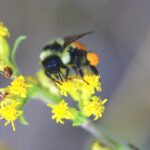Reading Time: 6 minutes It’s estimated that insects such as bees are responsible for pollinating almost 20 per cent of Canada’s crop, but that’s not the only reason for protecting their habitat. It’s also a breeding ground for beneficial insects that prey on cereal, oilseed and pulse crops. A recently completed study shows that simply “tweaking” agronomic practices can […] Read more

Less mowing, more flowers, more yield
A few tweaks to farm landscape management can improve life for beneficial insects

Putting a value on a shelterbelt
Yields drop immediately adjacent, but start to increase after 10 to 20 metres beyond
Reading Time: 4 minutes Areas such as road allowances, wetlands and shelterbelts take up land that could otherwise be used to produce grain. But does that mean that if you remove them, you’ll have more grain production? Maybe not. You might even get less, says Shathi Akhter, an Agriculture and Agri-Food Canada research scientist at Indian Head, Sask. She’s […] Read more

‘Farmscaping’ for profitability, sustainability
Applying some of the same principles from kitchen design can improve the environment and the workflow on the farm
Reading Time: 5 minutes “Farmscaping” might be a new term for many western Canadian producers, but it’s shorthand for a familiar set of ideas: building features like shelterbelts and perennial strips into the farm landscape to best utilize their ecological goods and services. In other words, taking a “whole-farm” approach, with the goal of maximizing profitability and sustainability. Joanne […] Read more

Give your insect friends a home
Leaving some non-crop areas with a diverse range of perennial vegetation can save you money on insecticide
Reading Time: 4 minutes What do shelterbelts, pivot corners and field margins have in common? No, they’re not unprofitable or “wasted” areas. As natural habitats for beneficial insects, including pollinators and predators of crop pests, those non-cropped areas may be worth their square footage in gold. Alejandro Costamagna, an assistant professor in the University of Manitoba’s department of entomology, […] Read more

Beneficial insects can fight in your corner, if you let them
A new field guide will be available both electronically and in print in time for you to use through the upcoming crop year
Reading Time: 6 minutes Farmers are only hurting themselves if they aren’t giving a helping hand to the natural allies in the fields that can assist them in controlling pests. Nature not only provides, as the old proverb says. Research proves that it also pays. In fact, new research even tells us how much it pays. Natural pest suppression […] Read more

Shelterbelts: a habitat for beneficial insects
Even if ripping out an old shelterbelt could help you work more acres per hour, it may leave you worse off
Reading Time: 5 minutes Back in the Dirty ’30s, farmers planted shelterbelts in a desperate bid to slow those drying winds and keep them from blowing our precious topsoil east. Now, at almost 100 years old, these wind-breaks have grown into stands of mature trees that continue to serve that purpose well. Not only do these shelterbelts curb wind […] Read more


